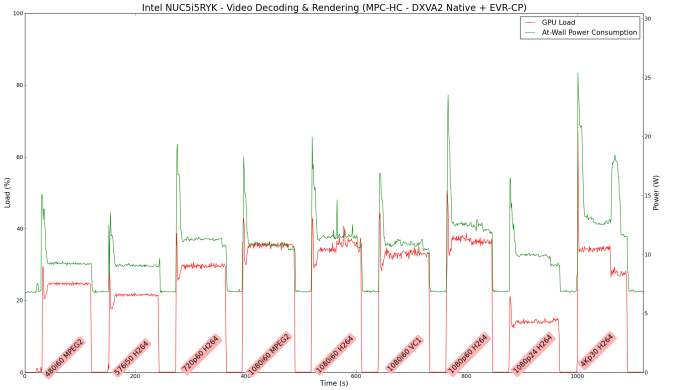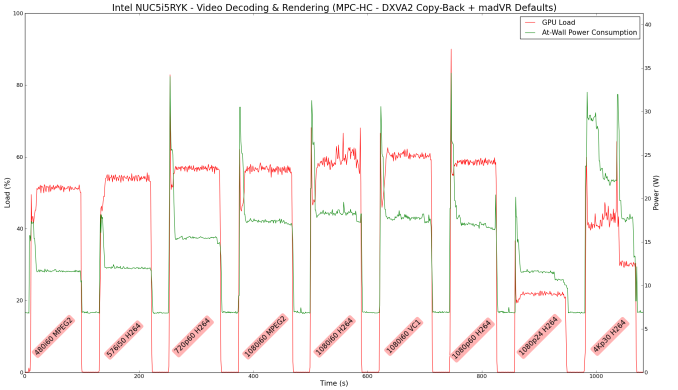Intel NUC5i5RYK Review: A Broadwell-U UCFF PC for Enthusiasts
by Ganesh T S on February 20, 2015 8:00 AM ESTHTPC Credentials
The NUC5i5RYK is a UCFF PC, but, thanks to the 15W TDP CPU inside, it doesn't require a noisy thermal solution. Subjectively speaking, the unit is silent for most common HTPC use-cases. Only under heavy CPU / GPU loading does the fan become audible. In our investigation, recent software improvements in the software chain for playback on Windows have lightened the stress considerably. The NUC5i5RYK definitely makes a good HTPC for folks who don't want to pay the premium for a passively cooled system.
Refresh Rate Accurancy
Starting with Haswell, Intel, AMD and NVIDIA have been on par with respect to display refresh rate accuracy. The most important refresh rate for videophiles is obviously 23.976 Hz (the 23 Hz setting). As expected, the Intel NUC5i5RYK has no trouble with refreshing the display appropriately in this setting.
The gallery below presents some of the other refresh rates that we tested out. The first statistic in madVR's OSD indicates the display refresh rate.
Network Streaming Efficiency
Evaluation of OTT playback efficiency was done by playing back our standard YouTube test stream and five minutes from our standard Netflix test title. Using HTML5, the YouTube stream plays back a 720p encoding. Since YouTube now defaults to HTML5 for video playback, we have stopped evaluating Adobe Flash acceleration. Note that only NVIDIA exposes GPU and VPU loads separately. Both Intel and AMD bundle the decoder load along with the GPU load. The following two graphs show the power consumption at the wall for playback of the HTML5 stream in Mozilla Firefox (v 35.0.1).

GPU load was around 13.46% for the YouTube HTML5 stream and 2.92% for the steady state 6 Mbps Netflix streaming case.
Netflix streaming evaluation was done using the Windows 8.1 Netflix app. Manual stream selection is available (Ctrl-Alt-Shift-S) and debug information / statistics can also be viewed (Ctrl-Alt-Shift-D). Statistics collected for the YouTube streaming experiment were also collected here.

For similar OTT streaming workloads, the NUC5i5RYK unit consumes slightly lower power at the wall compared to the corresponding Haswell NUC. That said, it is difficult to quantify how much of this is due to Broadwell moving down to 14nm. Other components such as the WLAN adapter, DRAM and even the power supply have changed between the two compared units. That said, the Core i5 U-based Broadwell NUC is more power-efficient for these workloads compared to the Core i7 U-based BRIX units.
Decoding and Rendering Benchmarks
In order to evaluate local file playback, we concentrate on EVR-CP and madVR using the mainstream configuration (which has the 1600 MHz DRAM). We already know that EVR works quite well even with the Intel IGP for our test streams. In our Broadwell BRIX s review, we found the HD Graphics 5500 to be incapable of downscaling 4kp30 to 1080p using default madVR settings. We didn't have much hopes for HD Graphics 6000 and our fears were confirmed when similar results were obtained with the NUC5i5RYK initially using the LAV Filters DXVA 2 Copy-Back mode in MPC-HC 1.7.8.
One of the odd aspects that we found in the course of the 4kp30 playback and downscaling process using madVR was that the GPU loading never went above 70%, but approximately half the frames were getting dropped. A careful analysis of the OSD revealed that the split queue was simply not able to keep up (with queues prior to that in the OSD being kept close to full). madVR's split queue copies the decoded frames from the GPU RAM to system RAM and then back to GPU RAM. However, this process seemed to be too slow for 4Kp30 content on the Intel IGP. Just as we were about to wrap up testing of the decoding and rendering aspects, LAV Filters 0.64 was released with huge improvements in DXVA Copy-Back performance. We repeated our benchmarks after overriding the in-built LAV filters of MPC-HC 1.7.8 with LAV Filters 0.64. 4Kp30 downscaling with madVR default settings worked without any dropped frames.
Usually, we suggest usage of the QuickSync decoder built into LAV Video Decoder whenever playback with an Intel IGP machine is desired. However, HEVC decode acceleration using DXVA (implemented partially in software) is available only in the DXVA2N and DXVA2 Copy-Back modes for Broadwell. Hence, we no longer recommend setting the default codec in LAV Video Decoder to Intel QuickSync.
In our earlier reviews, we focused on presenting the GPU loading and power consumption at the wall in a table (with problematic streams in bold). This time around, we decided to represent the GPU load and power consumption in a graph with dual Y-axes. Nine different test streams of 90 seconds each were played back with a gap of 30 seconds between each of them. The characteristics of each stream are annotated at the bottom of the graph. Note that the GPU usage is graphed in red and needs to be considered against the left axis, while the at-wall power consumption is graphed in green and needs to be considered against the right axis.
Points of concern would be GPU loading being consistently above 85 - 90%, but there is no such case in the two scenarios tested above. Power consumption at the wall is less than 15 W for even the most complicated streams when using EVR-CP, while madVR with DXVA2 Copy-Back decoding averages around 20 W for the higher complexity streams involving scaling for fast frame rate or high-resolution content.


















83 Comments
View All Comments
gfieldew - Saturday, February 21, 2015 - link
Damn, wrong post, please ignore.medi03 - Sunday, February 22, 2015 - link
Lack of AMD APUs in comparison charts is somewhat suspicious, to say the least.mits2k - Monday, February 23, 2015 - link
I am glad that Anandtech is evaluating 4K playback on these devices. Regular 1080p HTPCs seem to have reached a plateau in the past few years.I was confused by the evaluation of 4K scaled to 1080p. Are the new LAV filters that fix the scaling issues incorporated into the latest MPC-HC? Will LAV be taking advantage of the partially in-hardware 4K decoding via DXVA on Intel QuickSync soon? Does the HDMI output of this device support HDMI 2.0, enabling 4K/60p/4:4:4 color bit-depth? If not, does the DisplayPort support this bitrate? Will this device support HDCP 2.2 for protected 4K bluray output?
I bought an ASUS chromebox ($179 version) and have been successfully using it with my 4K monitor (Monoprice model) and 4K TV (Samsung). It renders the desktop in 4K30Hz, not at 60Hz. It is too slow/there is not appropriate software in linux to handle 4K videos without occasionally dropping frames, so I was going to upgrade to the NUC to handle this.
rangerdavid - Monday, February 23, 2015 - link
"The first Sandy Bridge NUC was important for two main reasons - the obvious one being the kickstarting of the UCFF craze."What, no nod to the Mac Mini, circa 2005? (Or even the G4 Cube if you want to geek out with me...)
Kidster3001 - Friday, February 27, 2015 - link
He didn't say NUC was the first but that it kick started the current popularity of the form factor.Haravikk - Wednesday, February 25, 2015 - link
I'm doing quite well on a small form factor system at the moment, using an i7-4790T (45W 2.7ghz quad-core, hyper-threading, 3.9ghz turbo and HD4600 graphics) in an Akasa Euler case. Only downside has been that I had to trade in the mSATA hard drive I was using for a regular 2.5" SSD, as the mSATA just got too hot in such a confined, passively cooled space.jasperjones - Wednesday, February 25, 2015 - link
I am shocked what you guys use as a HTPC. And what good are these SSDs in a HTPC???I use a rooted Amazon Fire TV as my HTPC (purchased for € 49 at the introductory rate for Prime customers). Thus far, it has handled everything I've thrown at it. By the time I need H.265 and 4K, I imagine another ARM box priced below a hundred bucks will be around.
To me, this NUC is a desktop replacement (for non-gamers) or a small-server replacement.
nerd1 - Sunday, March 1, 2015 - link
I have no idea why somebody is even bothering to try AMD - they are horrible.I am in market for small and lightweight PCs, and have used AMD once - it ate twice the current of NUC yet twice slower. So 1/4 performance per power. Oh and it wasn't that cheaper too.
piasabird - Tuesday, March 3, 2015 - link
Well I would just compare this to at least a desktop Pentium, i3,i5, i7 to see what the difference is. Is this weak slow running processor as good as say an i3 4330 that runs at 3.5 Ghz, with 4 Megs of Cache, and HD 4600 IGP?Ceois - Wednesday, March 4, 2015 - link
On the first picture from the BIOS gallery it says CPU Core Temp 51C. Isn't that a little too high for it being idle?